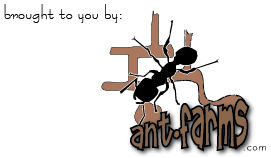Communication and Behavior of Ants
Communication between ants is primarily accomplished through the chemicals called pheromones. Ants have more developed chemical messages than other related species due to their constant direct contact with the ground. A forager who finds food leaves a pheromone trail along the ground on its way to the place it considers its home. This place is typically located through the use of remembered landmarks and the position of the sun as detected by compound eyes. It can also be through special sky polarization detecting fibers within the eyes.
This pheromone trail will be followed by other ants within a short period of time. The trail is further reinforced as it attracts more ants until the food is exhausted. With the food gone, the trail is no longer reinforced as it fails to further attract ants and slowly dissipates.
This particular behavior would explain how ants are able to easily adapt to changes in the environment. Ants merely leave an established path that has been blocked by an obstacle to find new routes towards its desired location. A successful discovery of another route results to the marking of the new trail by a returning ant, which is usually the shortest way.
The use of pheromone by ants serves other purposes. A crushed ant will emit an alarm pheromone which is capable of sending nearby ants into an attack frenzy when delivered in high concentration. An alarm pheromone in low concentration merely attracts other ants. It can even be used by the ants to confuse their enemies through the so-called propaganda pheromone.
Ants smell with their long, thin antennae, just like other insects. Their antennae are fairly mobile since it has a distinct elbow joint after an elongated first segment. They also come in pairs and are able to provide information about direction as well as intensity. Pheromones enable ants to detect what particular task groups other ants belong to. The queen also produces a certain pheromone that prevents the workers to begin raising new queens. Ants attack and defend themselves by biting or stinging.
It is believed that ants learn behavior by interactive teaching. This is the process by which a follower ant obtains knowledge from the tutoring of the nest-mate teacher. The teacher and the follower are acutely sensitive to the progress of the other.
Wasps are considered the ancestors of ants. However, unlike them, ants usually lose or never develop their wing and thus primarily travel by walking. There are some species of ants that are capable of leaping and gliding.
Gliding is the most common trait among arboreal ants. They use their flattened heads and legs to steer in a controlled fall until they again contact the trunk of the tree from which they fell or leaped to avoid predators. A notable specie that is able to leap is the Jerdon’s Jumping Ant.
There are species of ants that are known to attack and take over the colonies of other ant species. Some may be less of an expansionist but would still attack colonies to steal eggs or larvae which can either be eaten or raised as workers. Some ants rely on captured worker ants to care for them as they are unable to capably feed themselves. One such specie is the Amazon Ant.


